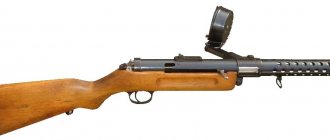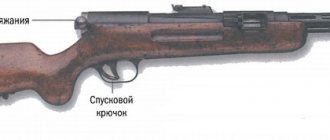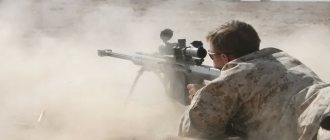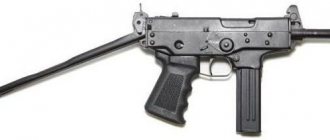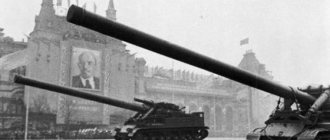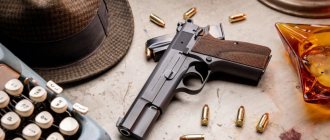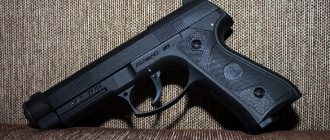The first Walther pistol appeared in the family arms company Walther Werke, which deals with hunting and sporting weapons, thanks to the persistence of the eldest son Fritz August of its owner Karl. The craftsmen did not give their products special loud names, denoting them simply and briefly - Model 1, Model 2, Model 3 and so on.
Pistol Walter
The weapon received markings later, when the army and police became interested in them - P 38 (Pistole and the year of serial production began in 1938) and PP (Polizei Pistole, entering the series in 1929).
Walter PP
History of the arms company
In Walter Werke's workshop in Zella-Mehlis, owner Karl Wilhelm assembled Martini sporting rifles. In 1903, the capacity increased to a three-story building, in which 50 workers worked on 50 machines. Of the master's five sons, three older brothers devoted themselves to gunsmithing - Fritz August, Georg Karl and Willy Alfred.
In 1908, Fritz improved the design of the Model 1 pistol, he convinced his father to add it to the company's range of hunting weapons, so the mobilization of the Walter family during the First World War, which began in 1914, was not affected. The company urgently increased its capacity, producing Model 1 pistols for the army as early as 1916 on 750 machines with the help of 500 workers.
Model 1
In the same year, the company received an order for machine gun bolts from MG08, Fritz created the Model 6 chambered for 9 mm, and took over the company due to the death of his father. In 1919, the Treaty of Versailles was concluded - the ban on the production of military weapons in Germany was observed for 1.5 years. The company survived solely on sporting weapons.
After the ban was lifted in 1920, the development of commercial weapons was allowed. Fritz develops three pocket pistols - the Model 8, Model 9 and Model 9A. By 1929, the PP series of police-style self-cocking pistols was developed, and all design errors were corrected. In 1931, modifications of the PP and PPK went into production for the 7.65 mm cartridge caliber. Later, weapon options appeared chambered for 6.35 x 15 mm, 9 x 17 mm and small-caliber .22LR.
Model 8
In 1931, the German Ministry of Defense considered that the Luger-Parabellum 08 no longer met the requirements of a personal army weapon:
- the cost of one unit exceeded $19;
- Luger was sensitive to contamination;
- the trigger did not allow shooting with gloves;
- ejecting cartridges upward is inconvenient when shooting from the body, as they hit the face.
Luger Parabellum
In the same year, a competition was announced for the development of inexpensive military weapons chambered for the 9 mm cartridge. Fritz Walter applied several original design innovations and provided Model 4 for testing:
- mathematically accurate weapon balancing;
- refusal of expensive handle cladding;
- reduction of material consumption and weight of the gun through the use of alloys and tin;
- reduction in cost to $14 per piece.
The weapon was named Walter P38 after the year it was launched into production. In the Wehrmacht army, the Luger Parabellum remained in service with the soldiers, and the officers switched to the Walter 9 mm caliber.
Walter P38
Fritz died at the age of 77 (1966), handing over the business to his son Karl, having managed to renounce the cross of merit during his lifetime and receiving the Diesel medal.
Manufacturing technologies
The production of weapons was made from alloy steel with high strength and corrosion resistance. The following techniques were used in production:
- heat treatment and hardening of the main parts - frame, barrel, bolt until the strength required for each element is achieved;
- cementation (carburization) of USM elements and connecting axes. The surface layer was diffusionally saturated with carbon when heated;
- treatment of the surface layer for wear resistance, maintaining the integrity of the cores of parts during bending;
- acid oxidation (rust varnish, rust bluing) - protection against corrosion of models from the First World War using a black oxide rust-like film;
- oxidation - in the interwar period and during World War II, weapons received strength;
- hot phosphating - treating steel parts of Parabellums with a phosphate coating in the 1920s.
"Parabellum" - the legendary German pistol
Interesting! The thickness of the carbon layer was no more than 1 mm. The elements became strong, ductile, and could withstand heavy loads.
Walter P38
Even before the Second World War, the modification of the Walther P38 received the name “officer’s Walther”. Considering that each division required approximately 4,000 units of these weapons, the Walter Company's capacity was not enough. Their production was mastered in Belgium and Czechoslovakia; from 1941 to 1945 alone, more than 10 million barrels were produced.
This is the most famous model of the Walter pistol from the Second World War, which went through the war and was highly valued as a captured weapon by Soviet officers. At different stages of design, testing and production, the Walther P38 had different designations:
- Model 4 - in internal documentation after receiving a patent for a USM latch that vertically locks the barrel;
- MP - Militar Pistole, a 9 mm military pistol, while working on an order from the German government to produce an inexpensive pistol to replace the Luger;
- AP - Armee Pistole, a 9 mm caliber army pistol, during the development of the latest version.
P38 design
Thus, in the AR model, the designers combined self-cocking, a secret location of the trigger under the casing, locking the barrel with a swinging latch, a flag-type safety and a short barrel stroke. When testing pistols at the Kumersdorf training ground in 1937, the military pointed out a number of shortcomings:
- high cost of weapons due to complex design;
- hidden trigger.
In the same year, Fritz changed the design of the casing and trigger, and changed the marking of the prototype to HP - Heeres Pistole (military pistol). By analogy with the RR police weapon, a cartridge indicator appeared inside the chamber. After simplifying the safety design, the HP version was approved by the Wehrmacht command, the pistol models received the final official name Walter P38 and went into production.
Characteristics
According to the requirements of the Wehrmacht army authorities, the pistol was created for 9 mm caliber. The characteristics of the weapon are as follows:
- production - Karl Walter's Waffenfactory, later Mauser Werke (Denmark) and Spriverk (Czechoslovakia);
- weight – loaded 990 g, without cartridges 880 g;
- dimensions – 21.6 x 13.6 cm (l/w, respectively);
- USM - trigger type;
- sight - rear sight, front sight;
- device – short recoil of the barrel, lever-type locking;
- USM - trigger;
- magazine – 8 rounds;
- firing range – 200 m maximum, 50 m sighting.
If you completely disassemble the weapon, the kit contains 58 parts. During manufacture, the pistol requires 4.4 kg of metal. Later, two types of suppressors were developed for special forces. The weapon does not need to be disassembled to install them, even partially.
Silencers for Walter
During the war, there was a loss and loss of weapons, so it was necessary to increase production capacity and reduce the cost of the design, therefore the pistol, disassembled in detail, underwent the following design changes:
- the casing and frame were made by stamping from a steel sheet;
- the cheeks became plastic (brown bakelite);
- Instead of bluing, a semi-matte coating was used;
- abandoned the cartridge indicator in the chamber;
- the quality of finishing has decreased.
Semi-matt coating of metal parts
Shortened versions of the Walter Z 38K were produced for SD and SS units.
Short model for the Gestapo
Varieties
After the Second World War, the German pistol received several copies and replicas:
- Walter R.4 – 10.4 cm barrel, police version;
- Walter R.1 - an improved modification, produced since 1957.
Umarex has created a pneumatic analogue of the Walter P38 for 4.5 mm caliber. Crosman company - two pneumatic replicas C41 and P-338. The manufacturer Bruni released the ME-38P starting pistol, and EPMA released the gas 38G and traumatic 38P.
Pneumatic replica weapon
Walter RR
Although pistols of the Walther PP modification appeared earlier than the P 38 - in 1929, they are less popular. This is explained by the fact that the weapon was created for the police and was used in very limited quantities in the Wehrmacht army. For comparison, about 1 million pieces were produced, that is, 10 times less than the “officer Walter”.
Two years later, in 1931, a shortened model of the RRK (Polizei Pistole Kriminal) was created. The PPK version was ideal for concealed carry and was used by wartime saboteurs, including Soviet ones. In the USSR, the Walter PP was a reward weapon and was used by diplomatic couriers.
TTX
By default, the technical characteristics of the Walter PP were as follows:
- dimensions – 17 x 10 x 3 cm (l/h/w, respectively);
- weight – 682 g;
- cartridge - 7.65 x 17 mm, 9 x 17 mm, less often 6.35 x 15 mm and small-caliber .22LR;
- ammunition - 8 rounds or 7 rounds in the magazine, depending on the caliber;
- range – 25 m.
By increasing the complexity of the design, the safety of the weapon has been increased. After setting the safety, you can safely drop it, reload it and carry it with a cartridge inside the chamber, and after removing the “flag” you can continue shooting.
Pistol safety
Modification of the PPK is 1 cm “lower” and 1.6 cm shorter (the barrel is 1.5 cm smaller and the frame is 1 cm smaller), 0.5 cm thinner. The front part of the bolt casing has a different look, weight is reduced to 590 g , the shot range remained unchanged.
The least frequently used pistols were the Browning 6.35 x 15 mm cartridge (1,000 weapons rolled off the production line).
Modifications
The following models of pistols are known, the basic design of which was PP and PPK:
- PP Super - created for the police in 1972 under the 9 x 18 mm Ultra cartridge;
- PPK/E – export version for the European market;
- PPK-L - manufactured in Germany since 1950, frame made of aluminum alloy;
- PPK/S – created for export to the USA under the 9 x 17 mm cartridge.
Pistol PPK/L
The Walter PP/PPK design was copied in China, France, Hungary and Turkey. Umarex and EPMA companies produce traumatic, gas and pneumatic copies of Walter PP.
Walter P5
The Walter P5 self-loading pistol was developed in 1979 and adopted by the police of the Bundeswehr, Portugal and Holland. Currently sold to European citizens. The main features of the P5 model are:
- trigger rod on the right side of the frame;
- Double action trigger;
- two return springs;
- short barrel stroke similar to Model 38;
- left-handed case extraction, which is convenient for left-handers;
- several safety devices.
P5 pistol design
For concealed carry, a variant of the Walther P5 Compact with similar performance characteristics, but smaller in size, was developed and launched into production. The second modification of the P5L is a sports version with an extended barrel.
Walter P22
Polymers were used for the body of the Walter 22 sports pistol; the casing and bolt remained steel. To fit the athlete, removable pads and sights are used. The weapon is a copy of the Model 99, but is shorter and uses a shorter 22 LongRifle cartridge. The combat rate of fire is within 40 rounds per minute, taking into account the reloading of a box magazine with 10 rounds. The weapon range has been increased to 350 m (maximum) and 50 m (aiming).
Walter P22 design
The Standard model has an 8.7 cm barrel, the Target has a 12.7 cm barrel. The Umarex company produces traumatic and gas modifications of weapons - P22T chambered for 10 x 22 m T and P22 chambered for 9 mm R.A., respectively.
Photo of the Parabellum pistol
Shutter closed
The shutter is cocked
Partial disassembly of the Luger P.08 Parabellum pistol
January 11, 2022 corrected by: OldMaster
Walter P88
In the XM9 competition, which was held by the US government to re-equip army sergeants and officers, the Walter PP double-action pistol participated with 9 more samples, but did not become the winner. therefore it was purchased by some armies and police units of other countries. The marking of the weapon includes the year of production launch (1988), but in 1996 the weapon was discontinued.
Distinctive features of the Walther P88 are:
- Browning barrel locking diagram;
- internal automatic fuse;
- magazine for 15 rounds of 9 x 19 Parabellum;
- weight 900 g and length 18.7 cm.
Walter P88 design
The sleek exterior of the weapon did not go unnoticed, so three sports models were released: P88 Competition, P88 Champion and P88 Sport (.22LongRifle cartridge). And the manufacturer Umarex has created a pneumatic copy of the CP88 Competition and a gas replica of the P-88 Compact for 4.5 and 9 mm R.A.K. cartridges, respectively.
Operating principle of walther p38
- When the bolt is pulled back, the cartridge, under the action of a spring, is fed from the magazine.
- When the bolt returns to its original position, the cartridge is fed into the chamber.
- The bolt engages the barrel.
- When fired, the bolt casing, under the influence of powder gases, moves to the rear position and ejects the cartridge case, and returning to its original position feeds a new cartridge.
Walther pistol cartridges
Several experimental versions were created in .45 ACP and .38 Super, but they were never mass produced. In addition to the 9mm Parabellum version, some 7.65x22mm Parabellum versions were also created and sold. It was also produced in 22LR caliber, and for the traumatic version the 9 mm PA cartridge was used.
